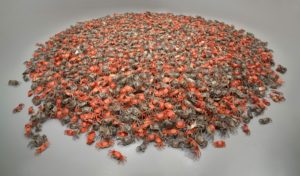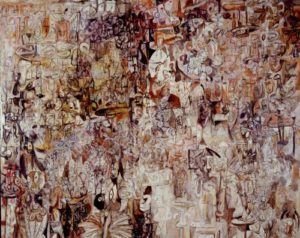He Xie by Ai Weiwei in the Brooklyn Museum’s “Ai Weiwei: According to What?”
As I was unable to attend the LACMA trip on 11/5, I am choosing to reflect upon Ai Weiwei’s He Xie, an installation that was part of the Brooklyn Museum’s exhibit “According to what?”, from April to August of 2014. “According to What” featured a diversity of important works than span Weiwei’s career, from his Coat Hanger portrait of Marcel Duchamp during his membership of the 1980s New York Avant-gard collective “Stars”, to his appropriated and painted over collection of Neolithic vases from the Han dynasty that reflected upon themes of collective memory and historical knowledge.

While it is difficult to remain complacent in the face of any of Weiwei’s interdisciplinary works, saturated with questions of representation, autonomy, freedom, and the roles of art in the social, political and cultural domains, I was particularly moved by the 3,200 porcelain crabs of his installation, He Xie. In the presence of this piece, I found the awe-inspiring scope elicited the gravity of the piece’s concept equally that was equally if not more immense. The installation is a type of residue or homage of a performance art conducted in 2010 in reaction to the ambiguous destruction of Weiwei’s new studio at the hands of the Chinese government. Weiwei openly invited all citizens via twitter to attend his “Shanghai River Crab Banquet” as a good-bye party for the studio. Similar to the word play of the panda project, the mandarin word for River Crab “hexie” is a homonym with the word “harmonious”. Due to China’s overuse of the word “harmony” to describe its filtering endeavors, “harmony” has become a synonym with “censorship” to the online community. Weiwei was promptly put on house-arrest hours before the gathering for threats of “subversion,” but the banquet continued regardless. Weiwei created not only a precedent to continue fighting for freedom of expression in the face of rebellion but also a platform for everyday citizens to do the same.
While the performance piece and resulting installation was born out of a circumstance specific to China, censorship is an issue that threatens the entire world. Experiencing the installation in walking distance from my home was a reminder of this universality and the potential art has through an artist arguably the most prolific, multitalented and revolutionary of the contemporary area to create multifaceted modes of social discourse that transcend national and geographic barriers as well as the conventional boundaries of medium.





